 |
The Teletext Museum. |
|
|||||||||||
 |
This page presents CEEFAX frames seen on BBC1 and BBC2 before 1991.
 |
This is a very early
CEEFAX page,
dating from January 1975 when the service was still classed
as experimental. Only 30 pages were broadcast, 8 of which were test pages. This page has been reconstructed from a black and white photograph so I do not know if/what colours were used. Can anyone help out? |
 |
The data for this image is taken
from BBC Engineering information sheet 4008 (issue 5) dated October
1975, and the date in the header row confirms the page is indeed of 1975 vintage. Talk about information fatigue syndrome!
But during the following three years the service develops... |
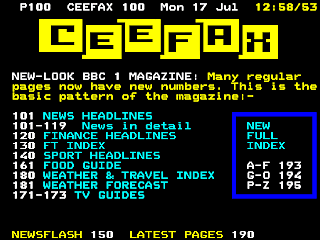 |
... and by 1978 there are two magazines filling 100 pages each. |
 |
The CEEFAX design is relaunched in the style which is to prove the blueprint for the service for many years to come... |
 |
All that's missing now are background colours. |
 |
This style of newsflash persisted for many years. |
 |
I wonder how many farmers had CEEFAX in 1978? |
 |
Not that without background colours the weather map looked much clunkier, requiring a blank cell to change foreground colour. |
 |
Press Reveal
for answers!
The Fun section (index 280 on BBC2) made early and extensive use of teletext's reveal/conceal feature. |
 |
|

|
By the late 1970s CEEFAX had standardised on sub-page labelling as 1/2, 2/2 etc. Previously, they had also used A B C, and if you were viewing sub-page A, then the A would appear flashing. Teletext graphics are something of an art form, and it is surprising what can be achieved with chunky blocks and eight colours. These black and white photos come from the Acorn Advanced Teletext System User Guide published in 1986 |
 |
This is a very rare
sighting of the lesser-spotted BBC2 main index page from May 1980,
when BBC2's CEEFAX service was branded as ORBIT.
Mike McGonagle reconstructed this page from a photo found in an article published in the American magazine Video Action in December 1980. (You can read the full article here.) The header row shows P198 (which at that time would only have been transmitted on BBC1), possibly because a magazine of selected pages had been set up there temporarily for demonstration purposes. Normally it would have been BBC2's P200. |
 |
This classic BBC1 CEEFAX
index dates from
1983... Thanks to Mark Cook and his (t)rusty BBC-B tape drive you can see the whole magazine (give or take a few sub-pages) and spend An Evening with CEEFAX! |
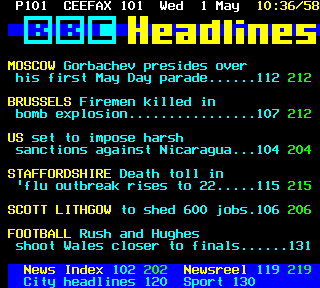 |
The next six pages date from
1985
Thanks to Mike McGonagle for reconstructing this page |
 |
I don't think all the page numbers were as indicated in the header row. |
 |
No road works between junctions 1 -9 - hooray! |
 |
Once again there is no weather in northern Scotland. |
 |
The much-missed Fun and Games section on BBC2 |
 |
NO NEED TO SHOUT!
Check out the old London 'phone prefix! |
| Christmas 1987 | |
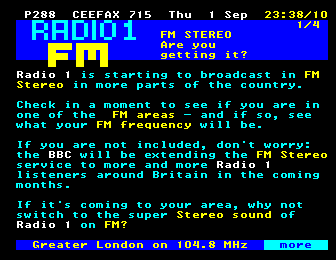 |
Remember the days when Radio One and Radio
Two shared the FM frequency? Well it wasn't really sharing, Radio Two had it most of the
time, with R1 allowed 2200-0000 every night and 1700-2200 on Sundays. I remember listening to the end of "Sing Something Simple" every Sunday, waiting for the Top 40 to come on. " S-t-e-r-e-o - 275 and 285 and Stereo V.H.F!" |
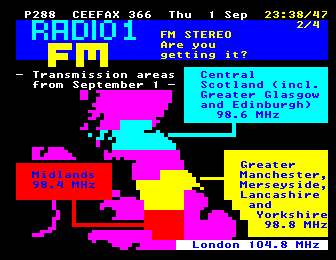 |
The full might of the CEEFAX
graphics
department is brought in to demonstrate where you can pick up the new Radio 1 FM service. The temporary frequency of 104.8 MHz allowed London to have Radio 1 in stereo well before the rest of the country. (Later it moved to 98.8 MHz.). |
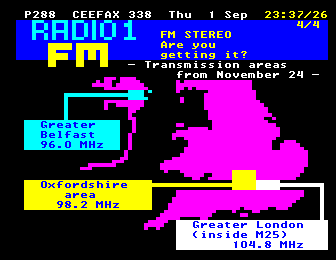 |
The frequencies were not freed up at the
same time, which meant that Radio 1 FM started off using all sorts of odd frequencies to
begin with. Belfast 96.0 MHz is now used by Radio 4 These three pages all date from 1988. |
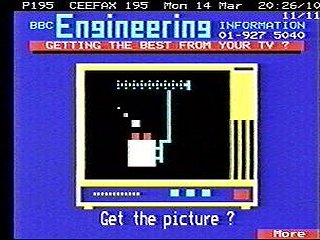 |
BBC Engineering graphic, 1988 |
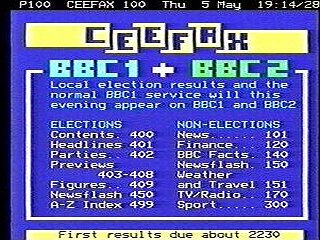 |
Election Night, 1988 |
 |
In September
1988 the BBC were increasing the
number of spare tv picture lines being used to transmit teletext. This
meant information could be transmitted faster.
Note the 01- telephone code for London. |
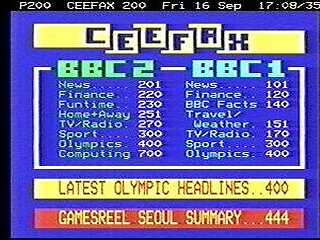 |
The BBC2 front page from September 1988 |
 |
A thought-provoking Fun and Games pages page from September 1988. |
 |
In April 1989 the BBC were suffering from industrial action. |
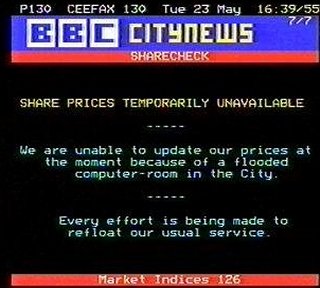 |
The CEEFAX Citynews staff showing humour in the face of adversity in May 1989. |
 |
Share prices from June 1989. Note that Eurotunnel are trading at 1099 |
 |
August 1989: Sad news of the end of the CEEFAX Fun and Games section, which had been a popular feature of the BBC2 service for ten years. |
 |
The BBC1 front page from November 1989 |
 |
Another late eighties style of page, this one showing a period when there were only three pages of weather, one page for the airports, but ten for the roads. The balance of features has consistently altered over time. 1990 |
 |
And now the weather. None for those of you in northern Scotland, the Orkneys or the Shetlands unfortunately. 1990 |
BBC teletext from
their newer services | CEEFAX
In Vision
CEEFAX
Regional-Extra | An Evening with
CEEFAX |
Christmas wiith CEEFAX
Telesoftware | SSVC | The
Beginning of the End
|
|||
|